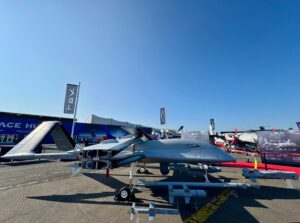
As Egypt hosts its inaugural International Airshow, India is making a notable presence through its leading aerospace companies, Hindustan Aeronautics Limited (HAL) and Bharat Dynamics Limited (BDL). This participation is expected to enhance India’s defence exports and bolster its regional presence. In the fiscal year 2023-24, India achieved a record high in defence exports, reaching $2.5 billion (`20,915 crore), with defence Public Sector Undertakings (PSUs) playing a pivotal role.
India’s aviation sector is poised for significant growth, driven by ambitious initiatives and strategic investments aimed at establishing the country as a global aviation leader. The 2024-25 budget reflects a substantial increase in defence spending, focused on upgrading technology and expanding domestic capabilities. Through supportive policies and strategic partnerships, India is committed to strengthening its domestic defence industry and advancing its position in the global defence technology arena.

HAL: A Pillar of Aerospace and Defence Excellence
Founded on December 23, 1940, Hindustan Aeronautics Limited (HAL) stands as one of the oldest and largest aerospace and defence manufacturers globally. With a legacy that spans over eight decades, HAL has cemented its position as a cornerstone of India’s defence and aerospace industry.
HAL embarked on aircraft manufacturing in 1942, marking the beginning of its esteemed history with the licensed production of the Harlow Trainer, Curtiss Hawk Fighter, and Vultee Bomber Aircraft for the Indian Air Force in collaboration with the Inter Continental Aircraft Company of USA. This early involvement laid the groundwork for HAL’s extensive portfolio, which now includes a wide array of aviation technologies and defence systems. Today, HAL operates many dedicated Research and Development (R&D) centers and manufacturing divisions. This extensive infrastructure supports HAL’s comprehensive engagement in the design, manufacture, and maintenance of a variety of aerospace and defence platforms, including fighter jets, helicopters, jet engines, marine gas turbines, avionics, and software development.
HAL’s commitment to innovation is exemplified by its design and development of several key platforms. Notable among these are the HF-24 Marut, India’s first indigenous fighter aircraft; the Dhruv, a versatile helicopter; the Light Utility Helicopter (LUH); and the Light Combat Helicopter (LCH). These advancements reflect HAL’s dedication to advancing India’s self-reliance in defense technology. In collaboration with the Defence Research and Development Organisation (DRDO) and Bharat Electronics, HAL has also developed indigenous products, including avionics and onboard weapons systems. This partnership underscores HAL’s role in supporting India’s vision of Atmanirbhar Bharat (self-reliant India)
HAL plays a crucial role in supporting Indian Space Research Organisation (ISRO) missions by providing integrated L-40 stages for GSLV Mk II, propellant tanks, and feed lines for PSLV, GSLV Mk II, and GSLV Mk III launch vehicles. Additionally, HAL contributes to satellite structures, showcasing its versatility in supporting both defence and space exploration endeavors. The company has also extended its expertise to the international market, supplying platforms such as the Dhruv, Lancer, Chetak, and Cheetah helicopters, as well as the Do-228 aircraft. HAL’s global outreach includes significant partnerships with leading international aviation firms like Airbus, Boeing, Rolls-Royce, Israel Aerospace Industries (IAI), and Rosoboronexport. These collaborations enhance HAL’s capability to deliver advanced technologies and provide ongoing product support worldwide.
HAL’s strategic emphasis on indigenization and technological advancement continues to shape India’s defence landscape. Programs like the Light Combat Aircraft (LCA) MK 1A, Light Combat Helicopter (LCH), and Light Utility Helicopter (LUH) are central to the Indian Air Force’s modernization efforts, reflecting HAL’s pivotal role in advancing national security and defence capabilities.

Bharat Dynamics Limited (BDL):
Pioneering India’s Missile Manufacturing
Founded in 1970 and headquartered in Hyderabad, Bharat Dynamics Limited (BDL) stands as a leading manufacturer of ammunitions and missile systems in India. Established with the objective of creating a robust manufacturing base for guided weapon systems, BDL began its journey by producing the French SS11B1 anti-tank guided missile. This initial step marked the start of BDL’s significant contribution to India’s defence sector, laying the groundwork for its future achievements in missile technology.
The advent of the Integrated Guided Missile Development Programme (IGMDP) in India marked a pivotal moment for BDL. The program, aimed at developing indigenous missile systems, identified BDL as a primary production agency. This recognition provided BDL with the opportunity to assimilate advanced manufacturing techniques and program management skills. Through its involvement in IGMDP, BDL became instrumental in the development and induction of several state-of-the-art missile systems, including India’s first surface-to-surface missile, Prithvi.
BDL’s portfolio includes a diverse range of missile systems designed to meet the varied needs of the Indian Armed Forces. One of its prominent products is the Agni series, with Agni-I being inducted into service in 1998.
This series of missiles has played a crucial role in bolstering India’s strategic capabilities. Additionally, BDL is responsible for manufacturing the Akash missile system, a medium-range surface-to-air missile capable of targeting aircraft up to 30 kilometers away and at altitudes up to 18,000 meters. This system, developed by the Defence Research and Development Organisation (DRDO), exemplifies BDL’s role in advancing India’s air defence capabilities.
In addition to surface-to-surface and surface-to-air missiles, BDL also produces specialized munitions such as the Advanced Light Weight Torpedo. This torpedo can be launched from ships, helicopters, or submarines and features versatile homing capabilities. BDL’s Counter Measures Dispensing System (CMDS) is another critical product, designed to enhance aircraft protection by misguiding incoming missiles through the use of chaff and flare dispensers. These technologies highlight BDL’s commitment to providing comprehensive defence solutions across various domains.
BDL’s portfolio also includes the MILAN 2T, a second-generation, semi-automatic, optically tracked missile with a tandem warhead, and the Konkurs-M, an anti-tank missile with capabilities to destroy armored targets equipped with Explosive Reactive Armor. Additionally, the Invar missile, fired from the T-90 Tank, showcases BDL’s expertise in developing high-velocity, jamming-immune weapons with advanced control systems. These products underscore BDL’s significant role in enhancing India’s defence infrastructure through innovative and effective missile technology.











